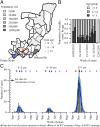The role of older children and adults in wild poliovirus transmission
- PMID: 25002465
- PMCID: PMC4115498
- DOI: 10.1073/pnas.1323688111
The role of older children and adults in wild poliovirus transmission
Abstract
As polio eradication inches closer, the absence of poliovirus circulation in most of the world and imperfect vaccination coverage are resulting in immunity gaps and polio outbreaks affecting adults. Furthermore, imperfect, waning intestinal immunity among older children and adults permits reinfection and poliovirus shedding, prompting calls to extend the age range of vaccination campaigns even in the absence of cases in these age groups. The success of such a strategy depends on the contribution to poliovirus transmission by older ages, which has not previously been estimated. We fit a mathematical model of poliovirus transmission to time series data from two large outbreaks that affected adults (Tajikistan 2010, Republic of Congo 2010) using maximum-likelihood estimation based on iterated particle-filtering methods. In Tajikistan, the contribution of unvaccinated older children and adults to transmission was minimal despite a significant number of cases in these age groups [reproduction number, R = 0.46 (95% confidence interval, 0.42-0.52) for >5-y-olds compared to 2.18 (2.06-2.45) for 0- to 5-y-olds]. In contrast, in the Republic of Congo, the contribution of older children and adults was significant [R = 1.85 (1.83-4.00)], perhaps reflecting sanitary and socioeconomic variables favoring efficient virus transmission. In neither setting was there evidence for a significant role of imperfect intestinal immunity in the transmission of poliovirus. Bringing the immunization response to the Tajikistan outbreak forward by 2 wk would have prevented an additional 130 cases (21%), highlighting the importance of early outbreak detection and response.
Keywords: epidemiology; infectious diseases; mathematical modeling.
Conflict of interest statement
The authors declare no conflict of interest.
Figures


References
-
- Global Polio Eradication Initiative 2013. Data and Monitoring. Available at www.polioeradication.org/Dataandmonitoring.aspx. Accessed November 8, 2013.
-
- Centers for Disease Control and Prevention (CDC) Outbreaks following wild poliovirus importations—Europe, Africa, and Asia, January 2009–September 2010. MMWR Morb Mortal Wkly Rep. 2010;59(43):1393–1399. - PubMed
-
- Anonymous Outbreak of type-1 wild poliovirus in adults, Namibia, 2006. Wkly Epidemiol Rec. 2006;81(45):425–430. - PubMed
-
- Centers for Disease Control and Prevention (CDC) Progress toward interruption of wild poliovirus transmission—worldwide, January 2011–March 2012. MMWR Morb Mortal Wkly Rep. 2012;61(19):353–357. - PubMed
Publication types
MeSH terms
Grants and funding
LinkOut - more resources
Full Text Sources
Other Literature Sources
Medical
Research Materials

